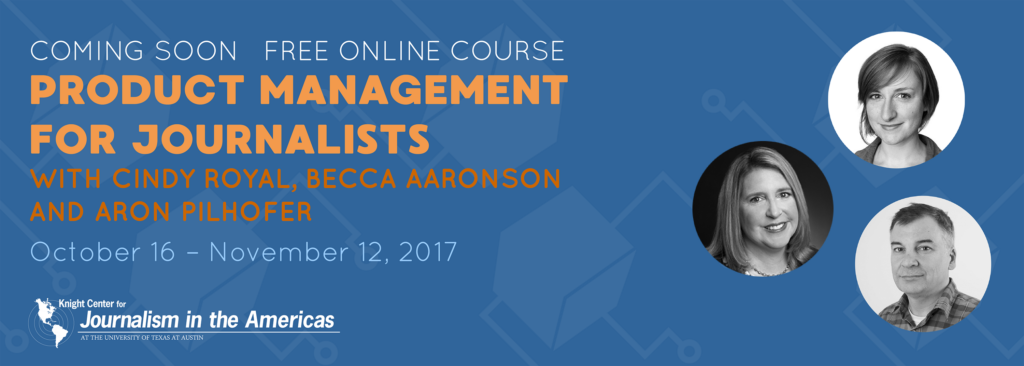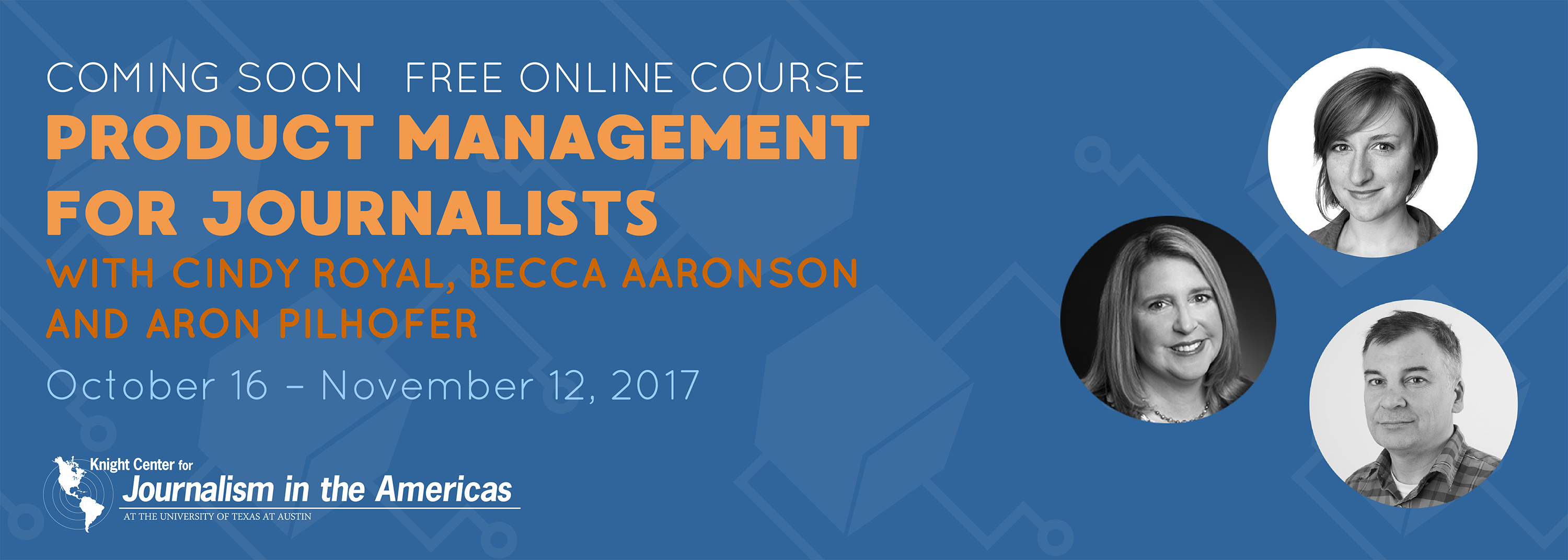
In recent years, newsrooms in the United States and other countries have created new positions such as “product manager,” “director of product” and “chief product officer.” Last April, at the Knight Center’s International Symposium on Online Journalism (ISOJ), a “product director” for The New York Times and a “director of product” for the Washington Post spoke on the same panel.
This managerial role dedicated to specific products (and not projects) is new in newsrooms, but has been common in tech companies for years. As news organizations create a variety of new interactive digital products, like bots, apps, newsletters, notifications, video and data presentations, newsrooms need to adopt new skills to develop, launch and manage them. This necessitates an entirely new role for journalists: product manager.
“Product Management for Journalists,” the next Massive Open Online Course (MOOC) offered by the Knight Center for Journalism in the Americas will teach how to manage digital products in news organizations interested in creating a culture of innovation in the newsroom, including, for example, the use of human-centered design methods.
This four-week course is free, entirely on the internet and asynchronous (there are no live activities, so participants can complete the course in days and times that are most convenient). It starts Oct. 16 and ends Nov. 12, 2017. Register now to reserve your spot!

Instructors Cindy Royal, Aron Pilhofer and Becca Aaronson will teach students how to successfully join the three main areas of concern for these digital products: users, technology and the business side.
“In this course, Aron, Becca and I will address the importance of integrating journalistic ethics and sensibilities into digital media products,” Royal said. “I am excited about the opportunity to discuss the nuances of this emerging role in newsrooms and journalism initiatives.”
The instructors for this course are pioneers in studying and implementing not only the use of digital tools and programming for journalism, but also the role of product manager for digital products in newsrooms.
Cindy Royal is professor in the School of Journalism and Mass Communication at Texas State University and also founding director of the school’s Media Innovation Lab. She is an expert in digital concepts and skills for journalists, and a witness to the incorporation of digital technologies in communications fields and academics over the past two decades.
Aron Pilhofer is associate professor and James B. Steele Chair in Journalism Innovation at Temple University in Philadelphia, Pennsylvania. An expert in using digital tools for journalism, Pilhofer was previously executive editor of digital for The Guardian and former editor of digital strategy at The New York Times.
In her role as product manager at The Texas Tribune, Becca Aaronson focuses on the news site’s technology products and their cohesion with audience and brand. Aaronson, a visual storyteller, started at the news non-profit as a journalist, but now works as a member of the engineering team.
Each week of the course is taught around a different module led by one of the instructors, who will provide tips and tricks along the way based on their experiences.
Week One, led by Royal, will look at the background and history of product management. During Week Two, Pilhofer will look at developing product management culture and strategy, including how to build a culture of change in the newsroom. For Week Three, Aaronson will overview executing a product management strategy, including measuring and outlining success, and will share design-thinking exercises for fostering creativity. And finally, for Week Four, Royal will go over best practices in product management strategy, including interviews with experts in product management positions at media organizations around the country.
During the four weekly modules of the course, students will consult videos, presentations and readings; complete exercises and quizzes; and participate in discussion forums.
For Royal, the basis for this course can be traced back to 2009. That year, she spent a week observing The Interactive News Technology department at The New York Times –then led by Aron Pilhofer– to get a closer look at the emerging role of journalist as programmer. The team was creating online, data-driven, interactive news presentations that required not only personnel with specialized skills, but new ways of organizing teams and information. At the time, no one was talking in terms of “product management,” despite the fact that these roles were now being forged in newsrooms as journalists adapted to new digital storytelling tools.
In the following years, Royal continued to study the evolution of data journalism and digital products in the nation’s newsrooms. As part of the Nieman Lab’s 2016 Prediction for Journalism, she estimated “media organizations and journalism schools will begin to comprehend and define product management and embrace it as a relevant and critical career path.”
Royal spoke with the innovators and early adopters of this new role for her project, “Managing Digital Products in a Newsroom Context,” looking at creative solutions and challenges coinciding with this latest newsroom evolution.
Now, Royal and her co-instructors will share the insights learned through their studies and practical experience to help course participants successfully create and manage their own teams and digital products.
“We are proud to offer this course to help journalists from the United States and around the world to understand another aspect of the reorganization of newsrooms to adapt to the new media ecosystem created by the digital revolution,” said professor Rosental Alves, founder and director of the Knight Center. “In Silicon Valley, product manager is such a common position that everyone knows it by the acronym PM, which now arrives to newsrooms involved in the launch of so many new digital products.”
The course is free and open to anyone who wishes to participate, but is ideal for journalists, journalism professors and students or communications graduates with a strong interest in and aptitude for technology.
Students who successfully meet course requirements, including participation in discussion forums, will receive a certificate of completion in PDF format after verification by the Knight Center. The certificate attests to participation in the online course, but no formal course credit of any kind is associated with the document.
The Knight Center for Journalism in the Americas was created in 2002 by Professor Rosental Calmon Alves, holder of the Knight Chair in Journalism at the Moody College of Communication School of Journalism at the University of Texas at Austin. The Center has received contributions from the John S. & James L. Knight Foundation and other donors. In 2015, the Knight Center’s distance learning program received a four-year grant from Knight Foundation that makes free online courses like this MOOC possible.